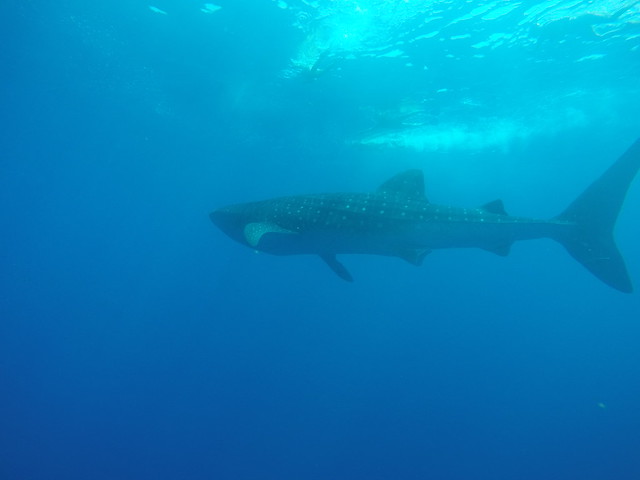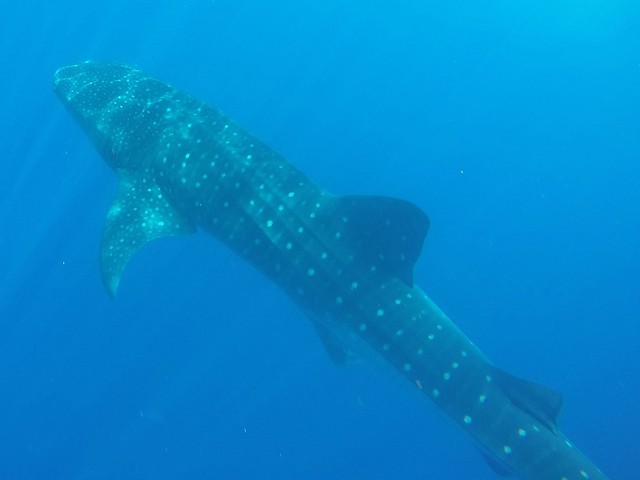Whale sharks are the largest fish in the world. Weighing around 20 tons and reaching lengths of over 40 feet, they are bigger than any other currently-living species of fish or non-mammalian vertebrate. They are slow-moving filter feeders, eating krill, plankton, and other tiny sea creatures. Their gentle nature, graceful movements, and tremendous size make whale sharks one of the more majestic creatures on the planet. We swam with some.
We had been in Roatan, one of the Bay Islands of Honduras, for a little over a week, enjoying the excellent diving, and were making plans to leave for Utila. Mom mentioned that there were whale sharks in Utila, and would we be interested in taking a tour to see them while we were there? Would we?! I should think so! It sounded just like the sort of incredible once-in-a-lifetime experience that we try to collect.
Utila is one of the few places in the world where whale sharks can not only be found year-round, but can be found easily, as their migratory route takes them past the Bay Islands. Whale sharks are very rare, secretive, and shy, and as a result, very little is known about their life cycle, breeding patterns, or migrations.
We arrived in Utila a few days later, after a short half-day passage. The weather would be calm and sunny for only a few more days, so one of the first things we did was to sign up the whole family for a tour the next morning with Bush’s Bay Island Charters. The trip would start at eight, and we would be out “whale-sharking” for several hours.
We had just finished breakfast when our captain came by in a dive boat. His name was Denny, a local guy whose family had originally come from Louisiana and the Cayman Islands. We got our snorkeling gear and cameras together, and loaded up. After a quick fuel stop, Denny took us around to the north side of the island, along the edge of the drop-off. The sharp peaks of the Honduras mainland were clearly visible to the south, while in the north, we could see the hills of Roatan low on the horizon.
On the way, he told us a little bit about finding whale sharks. Whale sharks eat plankton, an extremally abundant commodity in this area of the ocean, so they should be able to go wherever they want. But they don’t. For some unknown reason, whale sharks follow the schools of tuna, which feast on the bait-fish, which, in turn, feast on the plankton. Whale sharks can almost always be found near a tuna boil, a place where a school of tuna feeds near the surface. Then it is a simple matter of locating the shark, and jumping in on top of it. There were already several dive boats out looking for tuna boils when we got around to the north side of the island.
We soon found such a boil, and Denny told us to jump. We pitched ourselves over the side. The water was deep, disappearing into inky blue-blackness far below us. Tuna swam around in the upper few feet, snapping up bait-fish. Then we saw the whale shark. It was huge, maybe twenty feet long, greyish-blue and covered with white spots. It was most definitely a shark, and not a whale. It wasn’t just the fin alignment, the gills, or the vertical tail, there was something distinctly un-mammalian about it. Oddly enough, it wasn’t the least bit frightening. Maybe it was the knowledge that they had no teeth. The shark seemed shy, and soon ghosted off into the depths.
We got back in the boat, to look for the next boil. The sharks always seemed to be near the surface in the middle of a boil. Denny said that later in the afternoon, when the tide rose, they would become less skittish, sometimes letting snorkelers swim with them for 30 minutes or more.
By this time, the other dive boats had caught on, and were beginning to arrive. At the next boil, we were joined by a half-dozen other snorkelers. We didn’t mind; the pool was big enough for all. In total, we made five dives, with about 15 minutes in between. We saw a whale shark on each dive, sometimes two at a time. A few were over 30 feet long. They seemed more annoyed than scared at our presence. They would swim around for a few minutes, then go deep. We brought along a couple of cameras, and I got lots of video footage of whale sharks swimming majestically away from the obnoxious snorkelers.
Eventually, it was time to go. We climbed back into the boat, and Denny headed us for home. Rachel, justifiably a little leery of swimming in ridiculously-deep water with ridiculously-large fish, had elected to stay in the dive boat the whole time, but had still seen some from the surface. As for me, I’m happy I took the plunge. It will stand out as one of the highlights of our trip. If I’m going to swim with sharks, they might as well be 30 feet long.




